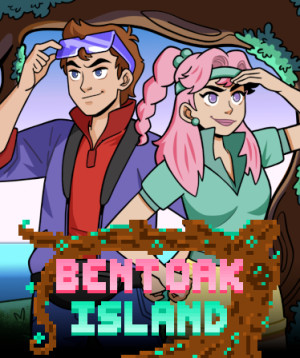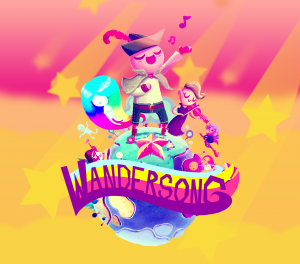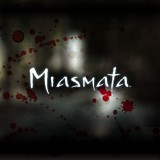Review for Yuppie Psycho

It would be easy to glance at Yuppie Psycho and identify it as eccentric. From the satirical commentary of its corporate setting to the grotesquery of corpses and viscera, with even a bit of sci-fi sprinkled in, it’s an unpredictable concoction. However, the game isn’t just bizarre for the sake of it, but surprisingly controlled and cohesive thanks to its clear personality and themes. An adventure game at heart, this pixel-styled survival horror by Baroque Decay is as comical as it is twisted.
A young man from the suburbs on the lower rung of society, Brian Pasternack has never been employed before. That is, until he receives a letter in the mail indicating that he has been selected for a position at one of the world’s largest corporations, Sintracorp. Not only is the pay more than he could have dreamed of, if he accepts the job he will immediately rise to the highest echelon of the caste system. Though he is concerned it might be a scam, Brian ultimately heads into the big city to learn of the letter’s legitimacy. Never could he have predicted how ill-equipped and unqualified he would be for the job – that of a witch hunter. Apparently a witch has existed within the Sintracorp building for years, corrupting the company from the inside. It is now up to Brian to uncover the mystery of the witch and find a way to end her terror.
Because the witch could be influencing the minds of his colleagues, Brian must stay on his toes. After all, they are a pretty suspicious bunch. His office mates are the devious jokester Hugo and the anxious, unassuming Sosa. Elsewhere, Kate keeps her nose to the grindstone but does her best to keep an affable disposition while the uncouth Chapman talks up his stature. There’s also the floozy Malone, the domineering Rostov, the tech-minded Doshi, and the enigmatic Mappy. Oh, and Colonel Dumont, who wears old-fashioned military attire and rides a horse through the building while attempting to motivate the staff. This cast is at the core of establishing Brian as a character and they ultimately create a complete picture of the oppressive nature of Sintracorp. Perhaps, though, the most important ally is the dubiously named Sintra, an AI who acts as your guide, sending you off to objectives and paying you upon success at each juncture.
You will become very familiar with the elevator during your trips up and down the building’s eleven floors. Your office on the fifth floor acts as a hub that you return to regularly to contact Sintra or have a watercooler chat with Hugo and Sosa. The second floor is a canteen which factors into Yuppie Psycho’s survival gameplay. The rest are consumed by the chaos of addled employees and supernatural happenings. It isn’t all cubicles and offices, however. You’ll also get to explore a garden, a crypt, an art exhibit, and a cramped hall overstuffed with workers scuttling aimlessly.
You are free to visit a majority of these floors from the beginning, but sticking to the critical path is recommended since you won’t have much to do until given explicit reason to be there. Thankfully, the game does a good job of giving directions and telegraphing areas and items of importance so you rarely, if ever, feel lost. No matter where you go, the most important thing to remember is to search everything you see. Cabinets, trash cans, briefcases – leave nothing untouched. Currency and consumables are tucked everywhere. In other cases, inspecting the environment can yield clues to puzzles or flavor text to flesh out the setting.
Given your choice of either keyboard and mouse or controller getting comfortable with the rebindable controls takes no time at all. Yuppie Psycho also has a low learning curve, explaining mechanics when needed but ultimately playing like a traditional adventure game: talk to people, collect things, solve puzzles. The briefcase Brian clings to at all times fills with what you pick up along the way. The inventory is sectioned into three different tabs wherein individual items can be inspected, used, or in the case of food and drink, ingested to replenish health. Puzzle-related objects must also be manually selected from this menu.
You won’t have to micromanage batteries for your flashlight, fortunately, as they are automatically changed when out of power. And you will burn through a lot of them given how often you’re thrown into pitch darkness, with only your cone of light as guide. If you run out of batteries, the strength of the light beam decreases dramatically. Later you will also have glowsticks at your disposal, which are dimmer than the flashlight but never run out and can even be dropped on the ground to keep a path illuminated.
The average puzzle isn’t overly complex, yet how they string together elicits a near constant feeling of accomplishment. Your first assignment is to obtain a book called the Hexenhammer, which supposedly reveals how to defeat witches. Sealed away in the archives, you will need to search a library, deciphering symbols that lead to bookshelves that will further yield the clues you require. A decidedly sillier puzzle has you corralling ad representatives who have wandered out of their workspace, crawling on all fours like animals. You will discover slogans in the area and can entice them into following you with the one that suits their interests most. And of course there are common inventory puzzles, requiring you to search for key items needed to progress.
When considering the survival horror aspects of Yuppie Psycho, it should be noted that there is no combat system. The closest things to weapons are pencils that take out certain stationary enemies when you get close enough, and even then you still use them as standard inventory. Enemies are the corrupted creatures that do the witch's bidding, most of which were once employees. What was previously the Human Resources department is now a pack of women with oversized lips in place of heads that spit acid from a distance. Another poor soul has a filing cabinet strapped to his back and tries to run you down on all fours, while in the garden location, firefly-like orbs deal damage when they touch you.
These monsters are positioned in various locations as planned encounters, often involving environmental interaction. You will elude some by ducking beneath tables or climbing into cabinets, which is a simple system as you cannot be harmed once you are hidden. Even if an enemy were giving chase, they will immediately give up after losing sight of you. These scenarios could certainly be more demanding, but giving players such ease of escape is a deliberate balance choice. Really it’s all about efficiently using cover to get from point A to point B while preventing or minimizing enemy attacks. If you're hit by anything nasty, you can track your health bar from the inventory screen. Brian can at least take a decent pummeling before seeing a Game Over.
The few bosses you confront have a more imposing presence but function more like puzzles in which you need to use your surroundings to your advantage. As an example, one such monster circles an arena you’re trapped in while you stumble around with your flashlight, ducking for cover between finding switches and flipping them in the right order to open an escape route, though if the creature sees you exploit a hiding spot it will secrete acid to drive you out.
To aid your survival in this harsh world of business suits and bloodthirsty monsters, the canteen grants you access to the appliances necessary to craft meals with more potent healing benefits than their individual ingredients. This is a safe location where you can prepare before setting out on your next objective. A helpful recipe sheet guides you through the combinations and associated equipment. If you have a couple slices of bread and a single slice of cheese, you can make a sandwich out of them. Got a cup of water? You may want to use it with some coffee beans, or perhaps some noodles. Frozen pizza? Stuff that into the microwave. The recipes are simple enough to remember, and interacting with the appliances will inform you whether or not you meet their requirements. Other means of maintaining your health bar are the lesser replenishing effects from candy and soda. If you run low on supplies, these can be purchased at vending machines. If stocked up on these already, your currency can be exchanged at a couple makeshift shops for such items as pencils and batteries. Note that the shops have limited stock as well.
At the outset, Yuppie Psycho cautions that there is no auto-save feature, which is technically untrue since it does create a handy save of its own before a certain late game event. Otherwise this warning is accurate since you must rely on “witch paper” to save your game – a consumable item that can only be used at the photocopy machines spread about the building. Fans of the classic Resident Evil series will make the comparison to ink ribbons and typewriters, as they function identically. The benefit of this system is that it makes you play more attentively and keeps you on edge about what might be around the corner for fear of losing progress. But don’t worry too much about the limited supply of paper; I saved at least a dozen times and still ended up with an unused handful. Same goes for ink cartridges, a resource that restores out-of-service photocopy machines, essentially creating new save points. Regardless, the challenge isn’t especially brutal so frustration is unlikely. I do think the game could use an additional, stricter difficulty for survival horror enthusiasts, but in its current state I believe players of all skill levels would enjoy the experience.
While not developed in Japan, Yuppie Psycho’s retro art style is certainly beholden to the influence of anime and manga. A number of dramatic moments are accompanied by short animated cutscenes that maintain the pixel aesthetic. In-game sprites are simple and blocky looking, but their close-up portraits during dialogue offer a good deal of expression, changing to suit the character’s mood and going so far as including details like Brian holding a paper up to his face when reading a note you found. What could be considered a shocking display of gore is cushioned by the cartoonish visuals, and while the content is undeniably macabre, it is not scary. That isn’t to say it doesn’t find moments to creep you out with subtle whispers in the dark and flashes of ghostly shapes, mind you.
Half of the game is dedicated to story, which in the absence of voice acting means a fair bit of reading. Dialogue options are rare, mostly for inquiring about information, but sometimes you will need to answer questions correctly to advance. Filling the quiet is Garoad’s score, which is unusually vast and masterfully keeps pace with the game’s tonal shifts. It’s synthy, jazzy, eerily solemn, and even sounds reminiscent of Silent Hill at times. Surely a soundtrack that would merit listening to outside of the game if available on its own.
If you relish uncovering secrets in games, Yuppie Psycho has many that are guaranteed to get you scouring its nooks. These can be as simple as unlocking shortcuts between areas to finding watchable VHS tapes featuring brief but intriguing and sometimes unnerving live action footage. You may decide to donate to the modest shrines you happen upon to see what might come of it. For more immediate rewards, you can give “electronic pieces” to Doshi to increase the width of your flashlight’s beam and a lantern that brightens a sizable 360-degree radius. There are even side objectives, like helping Chapman improve his rank in the company by passing a test overseen by men with boxes over their heads. If Steam achievements are an indicator, there are still many secrets left for me to uncover, not to mention endings I have yet to unlock (five in total). After about eight hours spent playing through the first time, I’m eager to jump back in and discover all there is to find in this gonzo adventure.
Yuppie Psycho’s gameplay systems and survival mechanics may not be especially deep on their own, but together they create an evolving experience where each step of the way fascinates with new scenarios and encounters to overcome. And though the story glosses over some details about the witch herself, it nonetheless culminates in a gratifying and ghastly satire that doesn’t sacrifice the horror element. Truly, I’m hard pressed to find any substantial negatives here. This is an adventure that never dulls, showing dexterity in tone and creativity in execution throughout.
WHERE CAN I DOWNLOAD Yuppie Psycho
Yuppie Psycho is available at:
We get a small commission from any game you buy through these links (except Steam).Our Verdict:
Balanced firmly between satisfying puzzles, survival horror gameplay, and an amusing story that satirizes the grind of corporate life, the odd but thoroughly engaging Yuppie Psycho has all the makings of a cult classic.












__medium.png)
















